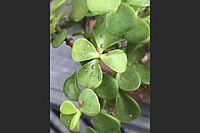Q This plant came up in my nieces' flower bed in Athens, Texas. [The reader sent a photo.] She says it smells horrible. Can you tell me what it is?
A The "plant" is actually a stinkhorn mushroom, so named for the foul odor the fungi emit. These mushrooms grow on decaying organic matter in a garden and often appear after a rain. They are not detrimental to the garden and actually are helping to break down organic matter; but while they are around, they smell pretty bad and can attract unwanted insects. Just knock them down when you see them, and that will reduce the smell.
■ ■ ■
Q The scale(?) on my oldest bonsai — going on 30 years now and one of my best and largest trees — has me concerned. Is there a chemical treatment that will eradicate them? It will go into a climate-controlled greenhouse in another month so whatever this is will likely continue to spread if I don't do something.
A There are some plant spikes that are made for houseplants which contain imidacloprid and can control the scale. You can also try spraying them with a horticultural oil before moving them in. I would not move this plant into the greenhouse until you have the scale under control. In a closed environment, it can spread to other plants. Create a "sick bay" in your house and isolate it in its own room. Once scale is dead, it will not disappear, but new foliage should come on clean. Since jade plants are not known for their rapid growth, and grow even slower in the winter months, your jade plant may need to stay isolated for some time.
Photo Gallery
In The Garden — October 30, 2021
Photographs to accompany Janet Carson's "In The Garden" column for October 30, 2021.
Q Attached are photos of diseased peony. It's about 2 years old and has been very healthy until about a month ago. I don't know if it's afflicted with sooty mold or powdery mildew. I seem to recall that you advise allowing peony foliage to die back on its own. Should I cut back the foliage and destroy it or let it die back on its own? Should I spray the surface area with something? I really need your advice. I don't want to lose this plant.
A Peonies are one of the first perennials to get growing in the spring, and often start to decline early. It is not unusual to see some damage to the foliage this late in the season. You have powdery mildew and a leaf spot. Whenever you see decline in the foliage, start cleanup — you do not have to wait for a frost to do so. As you clean up the damaged foliage, remove it from the yard. You might even want to remove the old mulch beneath the plant and start with fresh mulch. Good sanitation as plants go dormant can lead to healthier plants next spring. I would not do any fungicide sprays this late in the season, nor do I recommend a program next year — unless you see early signs of problems.
■ ■ ■
Q I'm overwintering my elephant ears so I can plant them in the spring. I've ordered some garlic and shallots. Can I plant them around the outside edge of the elephant ear containers?
A I would probably find a separate container. You will need to plant your elephant ears by April, and you would not harvest the garlic or shallots until probably June. I think you would disturb the planted garlic while replanting elephant ears, and unless the container is huge, it would be too much competition for the plants.
Retired after 38 years with the University of Arkansas Cooperative Extension Service, Janet Carson ranks among Arkansas' best known horticulture experts. Her blog is at arkansasonline.com/planitjanet. Write to her at P.O. Box 2221, Little Rock, AR 72203 or email jcarson@arkansasonline.com

